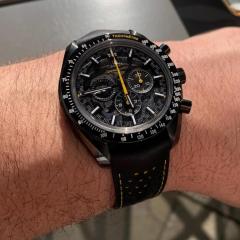-
Recently Browsing
- No registered users viewing this page.
-
Topics
-
Posts
-
I am pretty sure the correct practice to insert a tensioned crystal is to use a crystal press - although I always hate doing it as one slip and the crystal can skid across your dial, this happened to me on a Tissot, mangled all the hands and scratched the dial down to bare metal. I much prefer to remove the bezel and install the crystal into the bezel and then the bezel back onto the watch, not sure if this is an option for you?
-
Well, Geiger counter showed up today and the dial and/or hands were extremely radioactive, reading quickly spiked from a baseline of 10-20 cpm to 100 and was still rising when I removed it. Trashed the whole thing. Thankfully nothing else outside the components was registering - work surface, tools, the paper I had used to clean off some components.... And now I have a Geiger counter to use to check practice watches BEFORE disassembly
-
By HectorLooi · Posted
Usually the coiled spring contacts the piezo sounder and the finger spring is the ground. -
So I checked with my friendly local lab supplier and they can supply the following in 2.5 lt bottles: Tetrachloroethylene (B-Dip) - approx £65 Trichloroethylene (one-dip) - approx £43 n-Heptane 99% (Essence of Renata) - approx £35 Hexane - approx £45 I can't import or buy locally the 'real' products, hence the raw chemicals above. What do you think would be my best option? I'm edging towards Trichloroethylene - I know there are greater health risks, but given the very small quantities used for each treatment and 99.99% of the time it will be sealed in a jar, I think any risk is vanishingly small? This is mainly due to its assumed superior cleaning properties, or from the experience of this group, is the extra cleaning noticeable compared to its safer alternatives?
-
Unfortunately after much investigation, apparently the coil has been discontinued! Shall I get my service guy to try the solder or the conductive paint? 🎨 Final recommendation please🙏
-







Recommended Posts